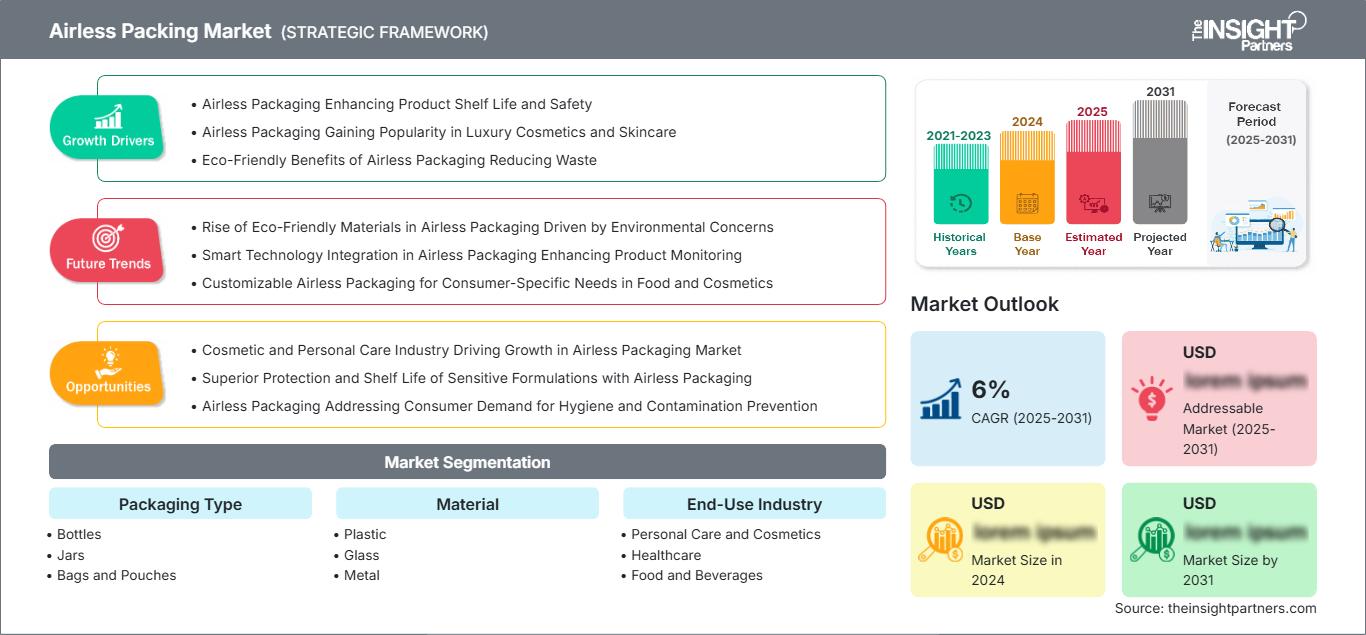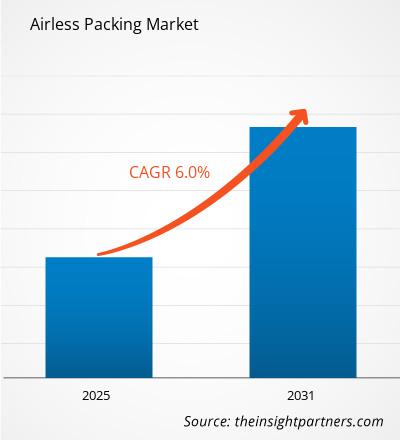Si prevede che il mercato della metilammina raggiungerà i 9,63 miliardi di dollari entro il 2031. Si prevede che il mercato registrerà un CAGR del 6,1% nel periodo 2025-2031.
Il rapporto è segmentato per tipologia di prodotto (bottiglie, barattoli, sacchetti e buste, ecc.). Il rapporto presenta inoltre un'analisi basata sul materiale (plastica, vetro e metallo). L'analisi globale è ulteriormente suddivisa a livello regionale e per i principali paesi. Le dimensioni e le previsioni del mercato a livello globale, regionale e nazionale per tutti i principali segmenti di mercato sono coperte dall'ambito di applicazione. Il rapporto fornisce il valore in dollari USA per l'analisi e i segmenti sopra indicati. Il rapporto fornisce statistiche chiave sullo stato del mercato dei principali attori e offre tendenze e opportunità di mercato.
Scopo del rapporto
Il rapporto "Airless Packing Market" di The Insight Partners mira a descrivere il panorama attuale e la crescita futura, i principali fattori trainanti, le sfide e le opportunità. Ciò fornirà spunti a vari stakeholder aziendali, come:
- Fornitori/produttori di tecnologia: per comprendere le dinamiche di mercato in evoluzione e conoscere le potenziali opportunità di crescita, consentendo loro di prendere decisioni strategiche informate.
- Investitori: per condurre un'analisi completa delle tendenze in merito al tasso di crescita del mercato, alle proiezioni finanziarie del mercato e alle opportunità esistenti lungo la catena del valore.
- Organismi di regolamentazione: per regolamentare le politiche e le attività di controllo nel mercato con l'obiettivo di ridurre al minimo gli abusi, preservare la fiducia degli investitori e sostenere l'integrità e la stabilità del mercato.
Segmentazione del mercato dell'imballaggio airless Tipo di imballaggio
- Bottiglie
- Barattoli
- Sacchetti e buste
Materiale
- Plastica
- Vetro
- Metallo
Settore di utilizzo finale
- Cura della persona e cosmetici
- Assistenza sanitaria
- Alimenti e bevande
- Cura della casa e altri
Geografia
- Nord America
- Europa
- Asia-Pacifico
- America meridionale e centrale
- Medio Oriente e Africa
Potrai personalizzare gratuitamente qualsiasi rapporto, comprese parti di questo rapporto, o analisi a livello di paese, pacchetto dati Excel, oltre a usufruire di grandi offerte e sconti per start-up e università
Mercato dell'imballaggio airless: Approfondimenti strategici

-
Ottieni le principali tendenze chiave del mercato di questo rapporto.Questo campione GRATUITO includerà l'analisi dei dati, che vanno dalle tendenze di mercato alle stime e alle previsioni.
Fattori di crescita del mercato degli imballaggi airless
- Gli imballaggi airless migliorano la durata di conservazione e la sicurezza dei prodotti: l'inclusione di sistemi di imballaggio airless impedisce l'intrusione di aria e altri contaminanti nel contenuto, migliorando notevolmente la durata di conservazione dei prodotti, soprattutto nel caso di prodotti cosmetici e farmacologici.
- Gli imballaggi airless stanno guadagnando popolarità nei cosmetici di lusso e nella cura della pelle: è opinione comune che gli imballaggi airless si trovino solo nelle linee di cosmetici sofisticate e costose che importano molti cosmetici di lusso e prodotti per la cura della pelle sul mercato.
- Vantaggi ecocompatibili degli imballaggi airless Riduzione degli sprechi: gli sprechi sono ridotti al minimo poiché è spesso possibile utilizzare l'intero prodotto con l'aiuto degli imballaggi airless. Inoltre, alcune unità airless sono ricaricabili o realizzate con materiali riciclabili, in risposta ai crescenti problemi ambientali.
Tendenze future del mercato del confezionamento airless
- Ascesa dei materiali ecocompatibili nel confezionamento airless guidata dalle preoccupazioni ambientali: l'urgenza di creare materiali più ecocompatibili per il confezionamento airless sta diventando un'area di grande interesse. Ciò si traduce in plastiche compostabili, materiali riciclabili, materiali di origine vegetale e altri materiali simili. Si prevede che la preoccupazione per l'ambiente e le risorse naturali sarà la causa di enormi innovazioni in questo ambito.
- Integrazione di tecnologie intelligenti nel confezionamento airless per migliorare il monitoraggio del prodotto: l'uso di tecnologie intelligenti in diversi imballaggi airless è un nuovo fenomeno sul mercato. Può anche includere una scatola di imballaggio IoT che monitora la quantità di prodotto consumata e se è ancora fresco, oppure un prodotto che eroga in base alle condizioni ambientali.
- Imballaggi airless personalizzabili per le esigenze specifiche dei consumatori nei settori alimentare e cosmetico: biscotti e torte vegetariani sono disponibili nei supermercati ed è possibile ordinare questi prodotti in grandi quantità. Si prevede che questa tendenza si rifletterà anche sul packaging. È possibile pensare a contenitori airless, che consentono ai consumatori di combinare diverse formulazioni o di regolare la presenza del principio attivo.
Opportunità di mercato per gli imballaggi airless
- Il settore cosmetico e della cura della persona traina la crescita del mercato degli imballaggi airless: il settore cosmetico e della cura della persona traina la crescita maggiore nel mercato degli imballaggi airless. Richiede integrità del prodotto, richiede un dosaggio preciso e richiede una presentazione premium, tutte caratteristiche che gli imballaggi airless eccellono nel fornire. E poiché i consumatori diventano sempre più esigenti riguardo ai loro prodotti di bellezza e cura della pelle, i marchi si stanno rivolgendo alle soluzioni airless per quell'importante richiamo visivo e per garantire l'efficacia del prodotto.
- Protezione e durata di conservazione superiori per formulazioni delicate con il confezionamento airless: i sistemi di confezionamento airless offrono una protezione superiore contro contaminanti esterni e ossidazione, un aspetto sempre più importante in diversi settori. Poiché creano un ambiente sottovuoto in cui il prodotto viene erogato senza che l'aria entri nel contenitore, ciò significa aumentare la durata di conservazione delle formulazioni delicate. Questo è particolarmente importante per i prodotti naturali e biologici delicati, privi di conservanti tradizionali.
- Il confezionamento airless risponde alla domanda dei consumatori di igiene e prevenzione della contaminazione: in risposta ai problemi sanitari mondiali e a una maggiore consapevolezza, i consumatori sono alla ricerca di soluzioni di confezionamento che limitino il tempo di contatto del prodotto con l'ambiente. Il confezionamento airless risolve questa esigenza perché impedisce al prodotto di entrare in contatto con aria o materiali estranei che potrebbero potenzialmente contaminarlo.
Mercato dell'imballaggio airless
Le tendenze regionali e i fattori che influenzano il mercato degli imballaggi airless durante il periodo di previsione sono stati ampiamente spiegati dagli analisti di The Insight Partners. Questa sezione illustra anche i segmenti di mercato e la geografia della gestione delle malattie del ritmo cardiaco in Nord America, Europa, Asia-Pacifico, Medio Oriente e Africa, America meridionale e centrale.
Ambito del rapporto sul mercato degli imballaggi airless
| Attributo del rapporto | Dettagli |
|---|---|
| Dimensioni del mercato in 2024 | US$ XX Billion |
| Dimensioni del mercato per 2031 | US$ 9.63 Billion |
| CAGR globale (2025 - 2031) | 6.1% |
| Dati storici | 2021-2023 |
| Periodo di previsione | 2025-2031 |
| Segmenti coperti |
By Tipo di imballaggio
|
| Regioni e paesi coperti |
Nord America
|
| Leader di mercato e profili aziendali chiave |
|
Densità degli operatori del mercato dell'imballaggio airless: comprendere il suo impatto sulle dinamiche aziendali
Il mercato dell'imballaggio airless è in rapida crescita, trainato dalla crescente domanda degli utenti finali, dovuta a fattori quali l'evoluzione delle preferenze dei consumatori, i progressi tecnologici e una maggiore consapevolezza dei vantaggi del prodotto. Con l'aumento della domanda, le aziende stanno ampliando la propria offerta, innovando per soddisfare le esigenze dei consumatori e sfruttando le tendenze emergenti, alimentando ulteriormente la crescita del mercato.

- Ottieni il Mercato dell'imballaggio airless Panoramica dei principali attori chiave
Punti di forza
- Copertura completa: il rapporto analizza in modo esaustivo prodotti, servizi, tipologie e utenti finali del mercato degli imballaggi airless, offrendo una panoramica olistica.
- Analisi degli esperti: il rapporto è redatto sulla base della conoscenza approfondita di esperti e analisti del settore.
- Informazioni aggiornate: il rapporto garantisce la pertinenza aziendale grazie alla copertura di informazioni e dati recenti.
- Opzioni di personalizzazione: questo rapporto può essere personalizzato per soddisfare le esigenze specifiche del cliente e adattarsi in modo appropriato alle strategie aziendali.
Il rapporto di ricerca sul mercato degli imballaggi airless può quindi contribuire a guidare il percorso di decodificazione e comprensione dello scenario del settore e delle prospettive di crescita. Sebbene possano esserci alcune preoccupazioni valide, i vantaggi complessivi di questo rapporto tendono a superare gli svantaggi.
- Analisi storica (2 anni), anno base, previsione (7 anni) con CAGR
- Analisi PEST e SWOT
- Valore/volume delle dimensioni del mercato - Globale, Regionale, Nazionale
- Industria e panorama competitivo
- Set di dati Excel
Report recenti
Testimonianze
Motivo dell'acquisto
- Processo decisionale informato
- Comprensione delle dinamiche di mercato
- Analisi competitiva
- Analisi dei clienti
- Previsioni di mercato
- Mitigazione del rischio
- Pianificazione strategica
- Giustificazione degli investimenti
- Identificazione dei mercati emergenti
- Miglioramento delle strategie di marketing
- Aumento dell'efficienza operativa
- Allineamento alle tendenze normative






















 Ottieni un campione gratuito per - Mercato dell'imballaggio airless
Ottieni un campione gratuito per - Mercato dell'imballaggio airless